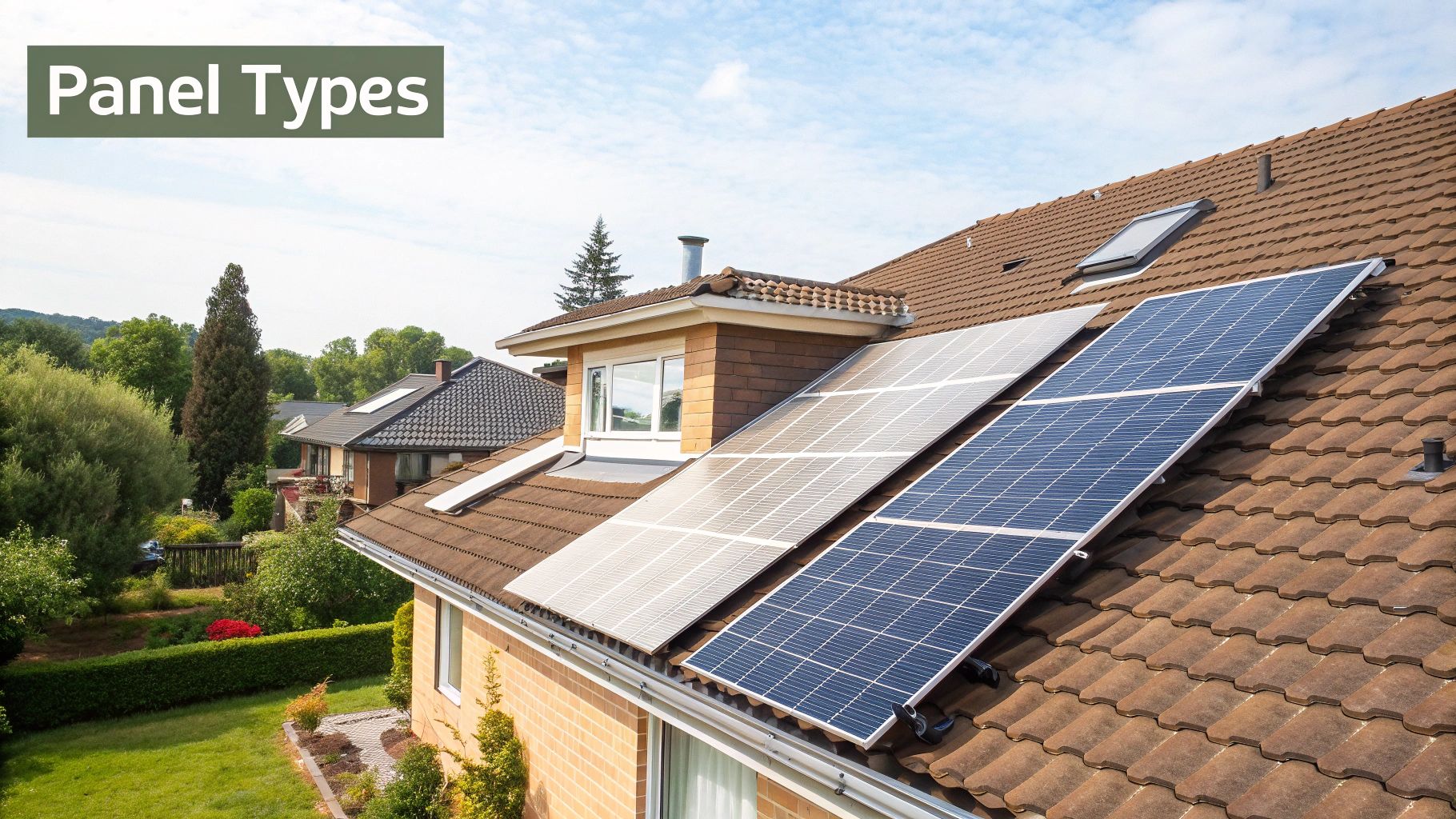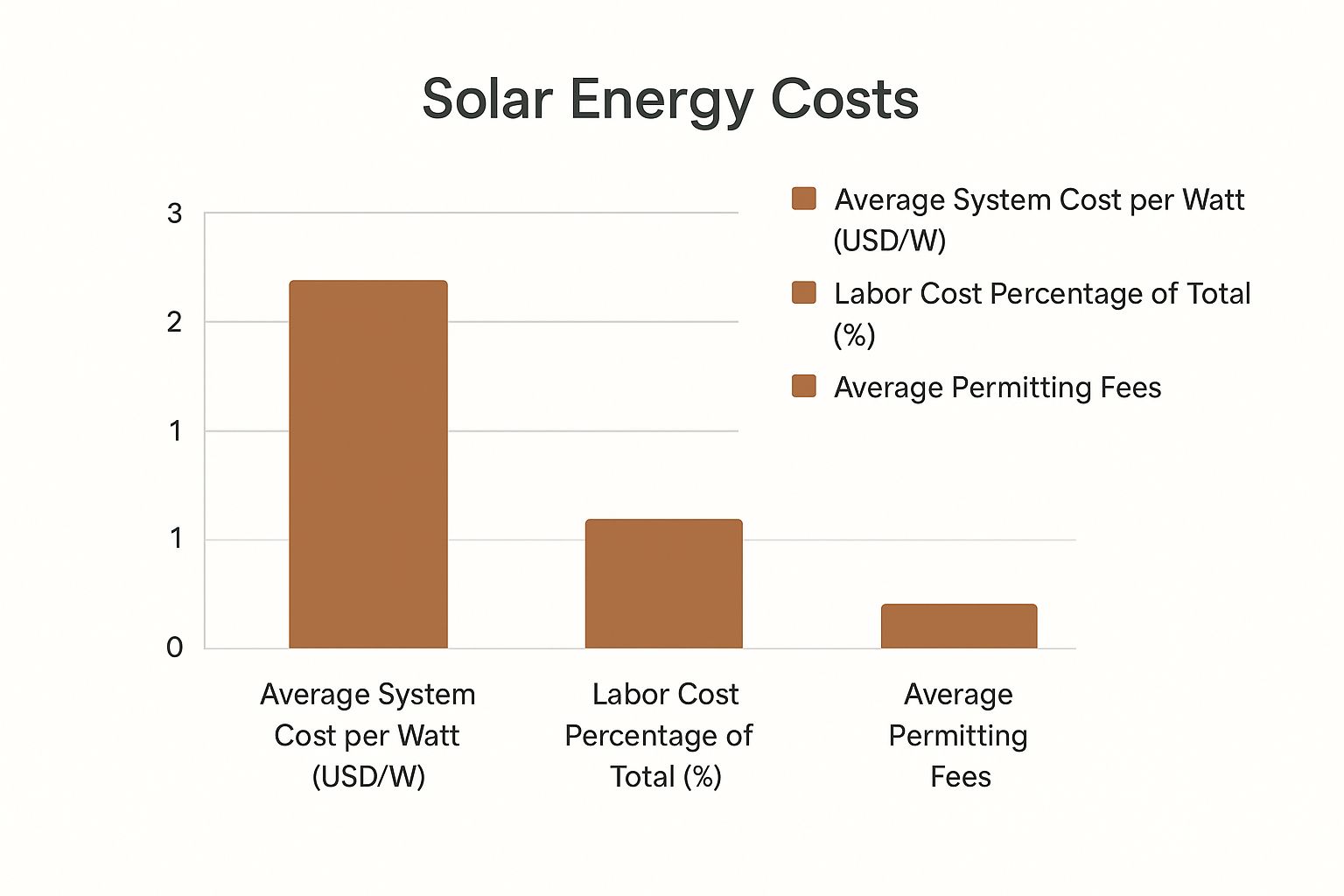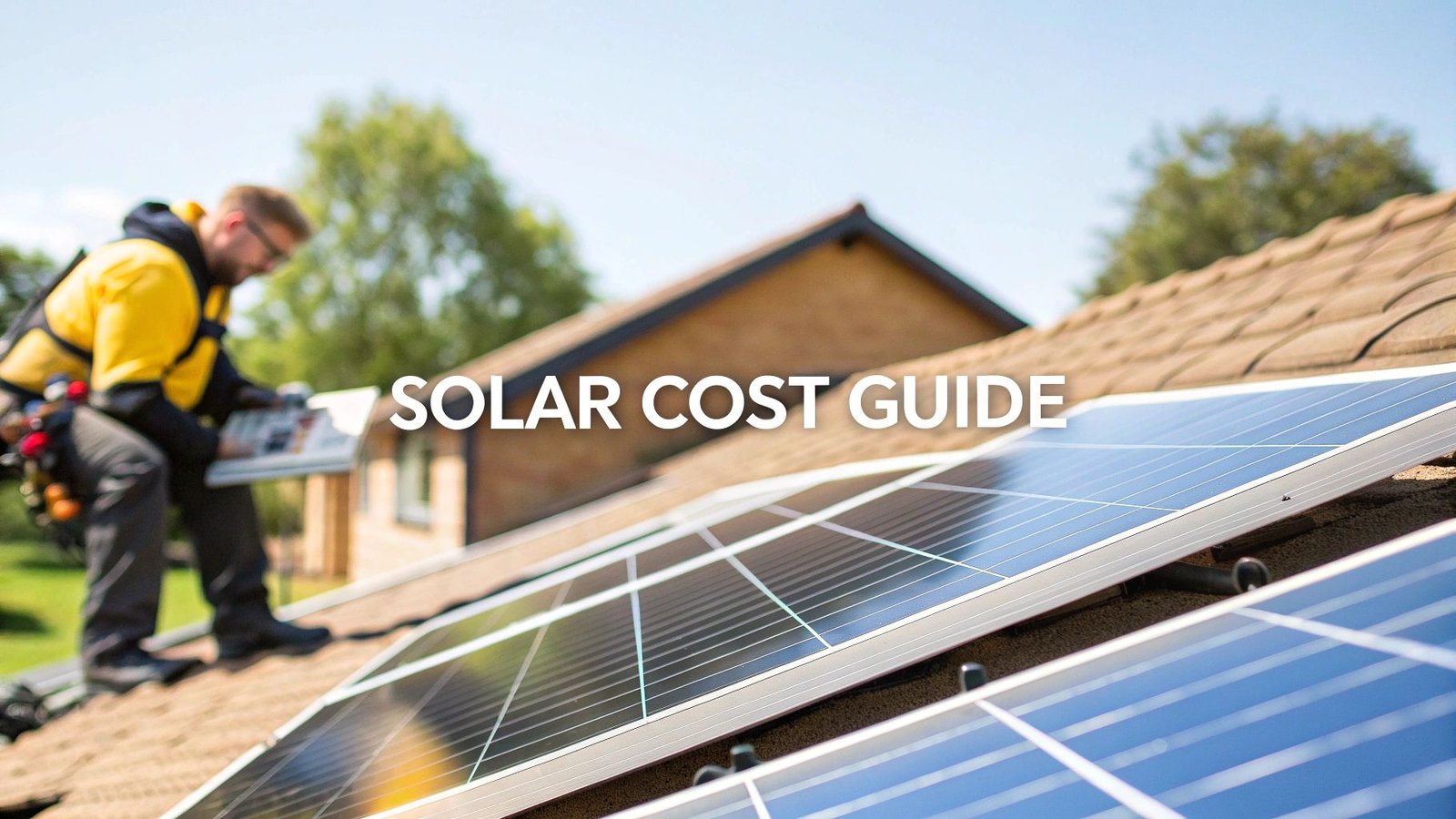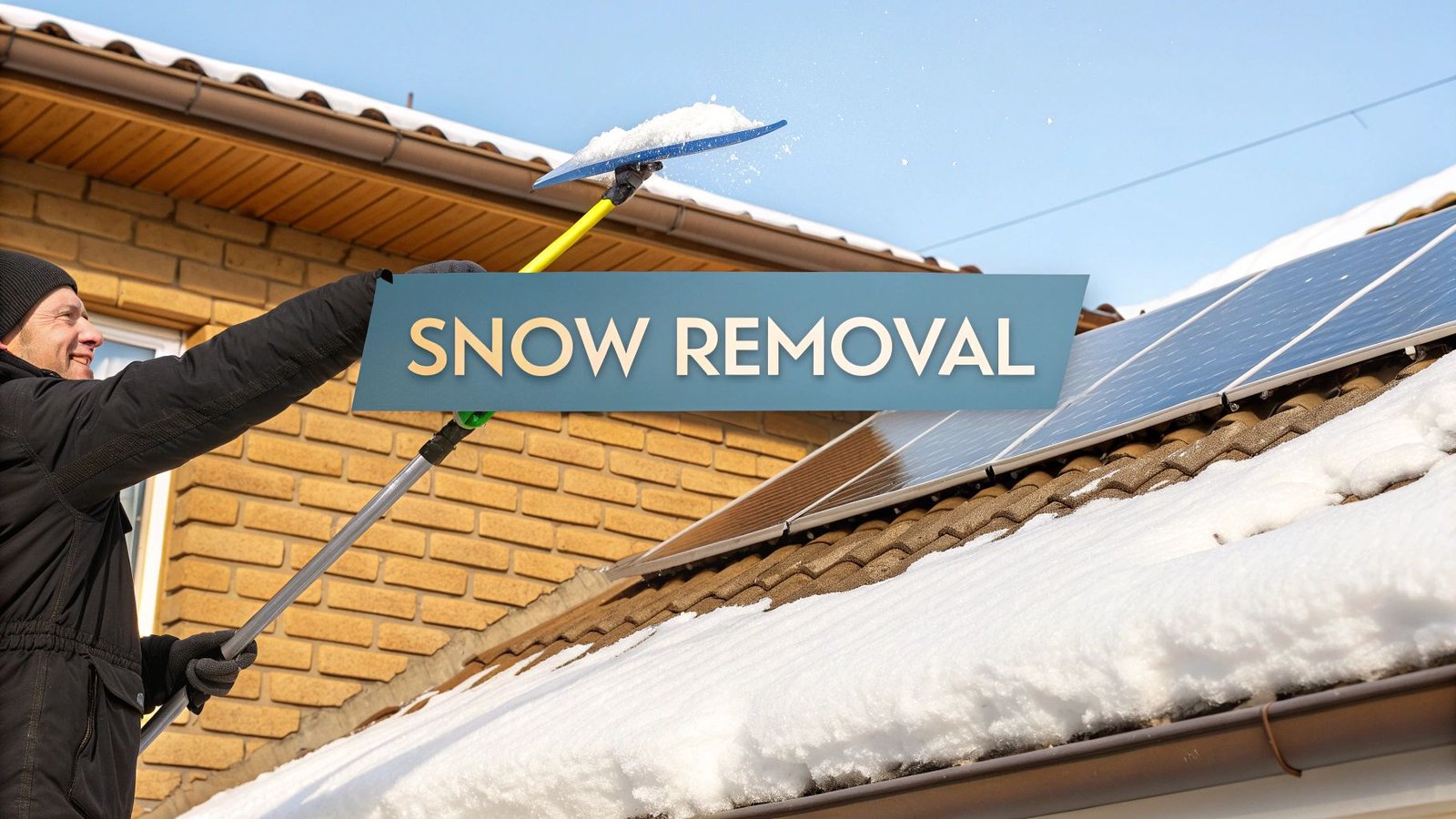Let's get straight to the point: the average solar panel system for a typical home runs about $20,754, and that's after the 30% federal tax credit kicks in. Before any incentives, you’re likely looking at a range between $25,000 and $34,000.
Of course, that's just an average. The final price tag depends on a lot of different factors, which we'll break down here.
Decoding Your Solar Panel Installation Cost
Trying to understand the final cost of a solar installation is a bit like buying a new car. The sticker price isn't just for the engine and the chassis; it rolls in everything from delivery and prep to registration fees. It’s the same with solar. The total cost is for a complete, turnkey system that turns your roof into your own personal power station.
This upfront investment covers several moving parts that all have to work together perfectly. You're not just buying hardware; you're paying for the skilled professionals who install it and the permits required to make sure everything is safe, legal, and up to code.
What Is Included in the Total Cost
To get a clear picture of your investment, it helps to see exactly where your money is going. The total solar panel system installation cost is a bundle of several critical elements:
- Hardware: This is the physical equipment—the solar panels, the inverters that convert DC power to usable AC electricity, the mounting racks that secure everything to your roof, and all the necessary wiring.
- Labor: You’re investing in the expertise of certified installers and electricians. These are the pros who handle the heavy lifting on your roof and safely connect your new system to the grid.
- Permits and Inspections: Your local city or county requires permits to start the work and inspections to sign off on it. These steps ensure your system meets all safety standards and building codes.
- Operational Costs: This covers the installer's overhead, which includes things like system design, engineering, project management, and customer support throughout the process.
Now, let's take a closer look at what a typical solar project costs, based on the size of the system.
Average Solar System Cost by Size Before Incentives
This chart provides a quick summary of typical solar system costs based on size, showing the average price range before any tax credits or rebates are applied.
graph TD
subgraph System Size
A[6 kW]
B[8 kW]
C[10 kW]
D[12 kW]
E[15 kW]
end
subgraph Estimated Cost Range (Before Incentives)
A1[$15,000 - $20,400]
B1[$20,000 - $27,200]
C1[$25,000 - $34,000]
D1[$30,000 - $40,800]
E1[$37,500 - $51,000]
end
A --> A1
B --> B1
C --> C1
D --> D1
E --> E1
Keep in mind these are just ballpark figures. The final price can shift based on the specific equipment you choose and your home's unique characteristics.
The True Price of Solar Panels
Here’s something that surprises most people: the solar panels themselves are a much smaller part of the bill than you'd think. In fact, the physical panels typically only make up about 12% of the total installation costs.
pie
title Cost Breakdown of a Typical Solar Installation
"Solar Panels" : 12
"Inverter" : 10
"Racking & Hardware" : 10
"Labor & Installation" : 28
"Permitting & Inspection" : 15
"Operational Costs (Overhead, etc.)" : 25
The bulk of the expense comes from everything else needed to make the system work. For a standard 12-kilowatt (kW) home system, the price-per-watt can change depending on where you live. For example, states like Arizona often have lower costs thanks to abundant sunshine and a competitive market. Over the system's 25-year lifespan, homeowners can expect to save anywhere from $34,000 to $120,000 on their utility bills, which really puts the initial investment into perspective. For a deeper dive into regional prices, you can explore the latest data on solar costs and savings from EnergySage.
Key Takeaway: The best way to think about the cost is to see it as a complete project—hardware, labor, and compliance included. It’s not just buying a product; it’s an infrastructure investment in your home's energy independence.
What Goes Into the Final Price Tag for Solar?
Ever wondered why two solar quotes for houses on the same street can be wildly different? The final solar panel system installation cost isn't a simple, off-the-shelf price. It’s a custom-built figure, unique to your home, your energy habits, and the gear you choose.
Think of it less like buying an appliance and more like commissioning a custom piece of work. The final cost depends on the materials, the complexity of the job, and the expertise of the crew. Getting a handle on these key variables is the first step to confidently sorting through quotes and making sure you're getting a great deal for your investment.

System Size: How Much Power Do You Need?
The single biggest driver of your total cost is the system size, which is measured in kilowatts (kW). This all comes down to how much electricity your family actually uses. A sprawling home with a pool heater and an EV charger in the garage needs a much bigger power plant on its roof than a smaller, energy-conscious bungalow.
To get this right, installers will dig into your past utility bills. The goal is to design a system that churns out enough electricity to cover most, if not all, of your annual consumption. It's a simple equation: the more power you need, the more panels you'll need, and that means a higher upfront cost.
Equipment Quality: The Standard vs. Premium Debate
Not all solar panels and inverters are built the same. The brands you choose have a major say in both the initial price and how well your system performs over the next 25+ years. It’s the classic balancing act between saving money now and getting more value over the long haul.
You can really break the equipment down into two main camps:
- Standard Equipment: These are the reliable workhorses of the solar world. They're budget-friendly, effective, and a fantastic choice if your main goal is to keep the initial investment as low as possible.
- Premium Equipment: This is your top-tier gear. High-efficiency panels and smarter inverters cost more, but they squeeze more power out of every square foot of sunlight. They also tend to degrade slower and almost always come with beefier, longer-lasting warranties.
Expert Insight: Premium panels are a game-changer for homes with small or partially shaded roofs. Their high efficiency means you can generate a ton of power even with limited space, so you don't have to scale back your energy goals.
Labor and Your Installer’s Expertise
The company you hire to put the system on your roof is a huge piece of the cost puzzle. It’s tempting to just jump on the lowest bid, but an installer's experience and reputation are critical for a project that will last for decades.
A more established, reputable installer might have a higher price, but here’s what you're often paying for:
- Deep Expertise: Seasoned pros have seen it all. They know how to navigate tricky installations and sidestep the common mistakes that can plague a project.
- Better Warranties: Companies that have been around for a while usually stand behind their work with strong labor warranties, giving you protection against installation hiccups for years.
- Quality You Can Trust: They don’t cut corners. They use top-notch mounting hardware and follow safety and electrical codes to the letter, ensuring your system is built to last.
It’s like hiring a master craftsman instead of a handyman. You’re paying for the peace of mind that comes with knowing the job was done right the first time.
Your Roof’s Shape and Condition
Your roof is the foundation for your new power plant, and its specific characteristics can definitely add to the bottom line. Before a single panel goes up, a good installer will give it a thorough inspection to spot any potential challenges.
A few things can make the job more complex and costly:
- Roof Age and Health: If your roof is getting old, it needs to be replaced before the panels are installed. The good news is most solar companies can roll a new roof into your project financing.
- Roof Material: Putting panels on standard asphalt shingles is a straightforward affair. But materials like clay tile, slate, or standing-seam metal require special mounting gear and more careful labor, which bumps up the cost.
- Roof Geometry: A simple, south-facing roof is the dream scenario. Roofs with steep pitches, lots of different angles, dormers, or skylights make the job trickier. They require more design work and custom racking, adding to the labor and material costs.
Permits, Paperwork, and Grid Connection
Finally, there's the behind-the-scenes administrative work that’s factored into your solar panel system installation cost. Your solar company has to get permits from your local city or county to make sure everything is up to building and electrical codes.
Once the system is built, they have to coordinate with your utility company to get official permission to connect to the grid. The fees for these permits and interconnection applications vary all over the map, but they are a non-negotiable part of any legitimate solar project.
On a brighter note, the cost of solar technology itself keeps dropping worldwide, making it an incredibly competitive source of energy. Recent research shows that the global Levelized Cost of Electricity (LCOE) for solar fell by about 21% in 2024, with more reductions on the horizon. This is mostly thanks to better manufacturing and more efficient panels, which helps absorb other project costs like labor and permitting. You can discover more insights about the falling global cost of renewables and see what it means for your wallet.
How Incentives and Rebates Lower Your Net Cost
The first quote you get for a solar installation is just the starting point. It’s a lot like the sticker price on a new car—it’s the number you see before any of the good stuff gets applied. The final solar panel system installation cost is almost always much lower, all thanks to a powerful mix of government incentives designed to make clean energy more affordable for everyone.
These aren't just minor discounts, either. We're talking about financial perks that can slash thousands, or even tens of thousands, of dollars off your total investment. Knowing where to find them and how to use them is the key to unlocking the true value of going solar.
The Federal Solar Tax Credit Explained
By far, the biggest financial tool in your corner is the Federal Solar Investment Tax Credit (ITC). This is the heavy hitter. It's not just a deduction that lowers your taxable income; it's a true dollar-for-dollar credit that directly reduces what you owe the IRS.
For any system installed between 2022 and 2032, this credit is a whopping 30% of your total project cost. And "total cost" means everything—the panels, inverters, labor, permitting fees, and even a solar battery if you install it at the same time.
To cash in on this powerful incentive, you just need to meet a few straightforward requirements:
- You must own the system. This means you either bought it with cash or are financing it with a solar loan. Leased systems or Power Purchase Agreements (PPAs) unfortunately don't qualify.
- The system has to be new. The credit is for new gear being put into service for the first time.
- You need to have enough tax liability. The credit can only reduce the taxes you actually owe. If your credit is bigger than your tax bill for the year, no worries—you can roll the leftover amount to the next tax year.
Digging Deeper with State and Local Incentives
While the federal credit is a fantastic start, the savings don't stop there. Many states, cities, and even local utility companies offer their own incentives that you can stack right on top of the ITC, dropping your net cost even further. These programs are all over the map, but they usually fall into a few main categories.
- State Tax Credits: Just like the federal one, some states offer an additional credit to lower your state income tax bill.
- Cash Rebates: Some states or utilities will give you an upfront cash rebate based on your system's size. It’s a direct payment that lowers what you have to pay out of pocket right away.
- Performance-Based Incentives (PBIs): Often known as Solar Renewable Energy Certificates (SRECs), these programs actually pay you for the clean energy your system produces. You earn credits for every kilowatt-hour your panels generate, which you can then sell.
- Property and Sales Tax Exemptions: Many states have passed laws to ensure that adding solar panels won't raise your property taxes, even though it clearly increases your home’s value. Some also offer a sales tax exemption on the solar equipment itself.
To give you a better feel for how diverse these programs are, here’s a quick look at what a few different states are doing.
Examples of State-Level Solar Incentive Programs
| State | Incentive Type | How It Reduces Your Cost |
|---|---|---|
| New York | NY-Sun Megawatt Block Program | Provides an upfront cash rebate based on the size of your system. The rebate amount decreases as more solar is installed in a region. |
| California | Self-Generation Incentive Program (SGIP) | Offers significant rebates for installing battery storage alongside your solar panels, reducing the cost of creating a resilient home energy system. |
| Massachusetts | Solar Massachusetts Renewable Target (SMART) | A performance-based incentive that pays homeowners a fixed rate per kilowatt-hour (kWh) their system generates over a 10-year period. |
| Arizona | Residential Arizona Solar Tax Credit | Offers a state tax credit of 25% of the cost of a solar system, capped at $1,000, which can be claimed in addition to the federal ITC. |
As you can see, your location plays a huge role in the final price tag. An installer who knows the local landscape is invaluable.
This chart breaks down the major cost components that these incentives help you tackle, showing the average expenses for hardware, labor, and all that fun administrative stuff.

As the chart shows, labor and permitting are a big chunk of the bill. That's exactly why tax credits covering the entire project cost are such a game-changer.
Stacking Incentives for Maximum Savings
The real magic happens when you start layering these benefits. Think about a homeowner in a state with great local programs. They could claim the 30% federal tax credit, get a state rebate check, avoid any new property taxes, and earn money from SRECs every month. This multi-layered approach can slash a system's payback period in half.
Key Insight: The true cost of a solar panel system isn't the number on the quote; it's the final price after you've claimed every single incentive available. A top-notch installer will be your guide to navigating federal, state, and local programs to make sure you get every dollar of savings you're entitled to.
Because these programs are always evolving, it’s absolutely critical to work with an installer who’s on top of the latest offerings in your specific area. They can give you a clear financial breakdown showing exactly how each incentive lowers your final solar panel system installation cost, turning what looks like a major expense into a smart, manageable investment.
Choosing the Right Way to Pay for Your System
Figuring out how to pay for your solar panel system is just as important as picking the right equipment. The path you take directly affects your upfront solar panel system installation cost, how much you save over the years, and ultimately, who owns that valuable asset on your roof. Let's walk through the four main ways to go solar so you can find the perfect fit for your budget.

Paying with Cash: The Direct Route to Ownership
Paying with cash is as straightforward as it gets. You cover the entire cost of the system upfront, meaning no monthly payments and zero interest. Think of it like buying a car with cash—once it's paid for, it's yours, no strings attached.
This approach delivers the absolute best return on your investment in the long run. Since you own the system from day one, you get to claim every available financial incentive, including the powerful 30% federal tax credit. All the energy savings go directly into your pocket. The only real hurdle is the significant initial investment, but if you have the funds, it's the fastest way to achieve energy independence.
Using a Solar Loan: Owning Over Time
For most homeowners, a solar loan is the go-to option. It lets you own your solar panels without having to liquidate your savings, spreading the cost out over a term of 10 to 25 years. It’s a lot like a car loan—you make predictable monthly payments until it's all paid off.
The best part? You still own the system, so you qualify for all the tax credits and rebates. In many cases, the monthly loan payment is actually less than what you were paying the utility company, so you can start saving money from the very first month.
You’ll generally encounter two kinds of loans:
- Secured Loans: These are often tied to your home's equity, like a home equity loan or HELOC. In exchange for using your home as collateral, you typically get the lowest interest rates.
- Unsecured Loans: These are personal loans that don't require collateral but might have slightly higher interest rates. Many solar installers, including us, offer these through lending partners to make the process seamless.
Financing has made solar accessible for more people than ever. In 2025, a full-size system costs anywhere from $24,000 to $36,000 on average. A solar loan might add $3,000 to $8,000 in interest over its lifetime, but the monthly payments are often still lower than the old electric bill, making it a financially smart move from the start.
Solar Leases: Renting Your Rooftop Power
A solar lease takes a completely different angle. Instead of buying the system, you're essentially renting your roof to a solar company. In return, you pay them a fixed monthly fee for the panels. This is a fantastic choice if your main goal is simply to lower your electricity bill with zero money down.
Key Difference: With a lease, the solar company owns and maintains the system. You just pay them a flat rate each month for the clean energy it produces—a rate that’s usually lower than what you’d pay your utility.
Since you don't own the equipment, you won't be eligible for the federal tax credit or other ownership-based perks; the leasing company gets those. It's a low-risk, low-hassle way to go solar, but your long-term savings will be less than if you had purchased the system yourself. To see how ownership aligns with our values, you can learn more about our mission at Radiant Energy.
Power Purchase Agreements (PPAs): Paying for Power, Not Panels
A Power Purchase Agreement (PPA) feels a lot like a lease. It also comes with zero upfront cost, and the solar company continues to own and maintain all the equipment. The real difference is in how you pay.
Instead of a fixed monthly rent, you agree to buy the electricity your panels generate at a pre-determined price per kilowatt-hour (kWh). This rate is almost always cheaper than what the utility charges. So, if your system produces 800 kWh in a sunny month, you simply buy that power from the solar company at your locked-in PPA rate. It's a true pay-as-you-go model for clean energy.
Both leases and PPAs are great for homeowners who want immediate savings without the responsibilities of ownership. However, it's important to remember that buying your system will always deliver far greater financial returns over its lifetime.
Calculating Your Long-Term Savings and Payback
It's easy to get fixated on the initial solar panel system installation cost, but that's only half the story. The real conversation starts when you stop seeing solar as an expense and start treating it like a long-term investment in your home. This is where we look past the price tag and get to the good stuff: how much you'll save and how quickly the system pays for itself.
Figuring out your solar payback period isn't some complex financial wizardry. It’s a straightforward calculation that shows you the true lifetime value of going solar. Think of it as mapping the point where your roof stops being just a roof and starts actively making you money.
The Simple Payback Period Formula
At its core, the payback period is just the time it takes for your energy savings to completely cover your initial investment. The formula itself is refreshingly simple.
Total Net System Cost ÷ Annual Savings = Payback Period in Years
The total net system cost is what you actually paid out of pocket after all the tax credits and rebates came through. Your annual savings are simply the money you would have sent to the utility company. Let's walk through how to find those numbers.
Step 1: Find Your Net System Cost
First things first, you need your real, final cost. This isn't the number on the top of the proposal; it's the price after all the financial perks are factored in.
- Gross System Cost: Start with the total price from your installer.
- Federal Tax Credit: Immediately subtract 30% of that gross cost.
- State & Local Rebates: Then, subtract any other cash-back incentives you qualify for.
What's left is your true investment—the number we'll use to calculate your payback.
Step 2: Calculate Your Annual Savings
Now for the fun part: figuring out how much you'll save every year. The easiest way to get a solid estimate is to dig up your last 12 months of electricity bills and find your average monthly payment.
Take that average and multiply it by 12. For instance, if you're used to paying $200 a month, your annual savings just became $2,400. That's money that stays in your bank account, not the utility's. This is also why it's smart to explore high-efficiency equipment that squeezes every last drop of power from the sun—you can learn more about the solar products we offer and see how better tech boosts your savings.
A Real-World Payback Example
Let’s put it all together. Say a homeowner named Alex gets a quote for a new solar system.
- Gross System Cost: $30,000
- Federal Tax Credit (30%): -$9,000
- State Rebate: -$1,000
- Net System Cost: $20,000
Next, we look at the savings side of the equation.
- Average Monthly Electric Bill: $180
- Annual Savings ($180 x 12): $2,160
Now we can plug these numbers into our simple formula:
$20,000 (Net Cost) ÷ $2,160 (Annual Savings) = 9.25 years
So, in just over nine years, Alex’s system has officially paid for itself. For the next 15+ years of the warranty, every bit of energy produced is pure, tax-free savings.
gantt
title Solar System Payback Timeline (Alex's Example)
dateFormat YYYY-MM-DD
axisFormat %Y
section Investment & Payback
Investment Period : crit, 2024-01-01, 9.25Y
section Pure Savings
Savings Period : 2033-04-01, 15.75Y
Key Insight: The payback period is the tipping point. It's the moment your solar panels stop being an investment and start being a money-saving machine. Everything generated after that is your return, which often adds up to tens of thousands of dollars.
Factors That Accelerate Your Payback
While our example gives a great baseline, a few real-world factors can actually speed things up. The biggest one? Rising utility rates. If your local electricity costs climb by 3-5% each year (which is pretty common), your savings will grow right along with them, shaving time off your payback period.
On top of that, some states offer performance-based incentives like Solar Renewable Energy Certificates (SRECs). These programs create an extra stream of income that can slash years off your break-even timeline. Once you understand these variables, it becomes clear that a solar investment only gets more valuable over time.
Common Questions About Solar Installation Costs
https://www.youtube.com/embed/SsItWJ46_lg
Once you start digging into the details of going solar, a lot of practical questions naturally pop up. You've got a few quotes in hand, you're getting serious about making a decision, and now you need to understand the finer points. This is where we clear the air on the most common concerns we hear from homeowners every day.
We'll walk through everything from why quotes can seem all over the map to whether those high-end panels are really worth the money, so you can feel completely confident in your final decision.
Why Do Solar Installation Quotes Vary So Much?
It's definitely confusing when you see one quote that’s thousands of dollars higher or lower than another. Almost every time, that price difference boils down to three things: the quality of the equipment, the installer's experience, and the strength of the warranties they offer.
A lower bid might look tempting, but it could be using standard-efficiency panels with a shorter lifespan to keep that initial number down. A higher quote, on the other hand, is probably built around premium, high-efficiency equipment designed to perform at a high level for 25 years or more.
Pro Tip: Never just look at the final price tag. A good quote will break everything down for you—the exact panel and inverter models, the warranty terms for the equipment, and the installer's own workmanship guarantee. That’s how you make a real apples-to-apples comparison.
Are Expensive Solar Panels Actually Worth It?
In most cases, yes—investing a bit more upfront in premium panels pays for itself over the life of the system. While the initial cost is higher, the superior technology delivers real-world benefits that often lead to a much better return on your investment down the road.
Here’s a quick breakdown of why they’re often the smarter financial move:
- Higher Efficiency: Premium panels squeeze more electricity out of the same sunlight. This is a game-changer if you have limited roof space or some tricky shading, as it helps you produce as much power as possible.
- Slower Degradation: Every solar panel loses a tiny fraction of its efficiency each year—it's just a fact of life. The best panels, however, degrade much more slowly. That means in year 20, they'll still be cranking out more power than a standard panel would.
- Better Warranties: The top-tier manufacturers back their products with the industry’s best warranties, often covering performance and materials for a full 25 to 30 years. That’s a serious guarantee of quality.
What Hidden Costs Should I Look Out For?
A truly professional installer will be transparent from the get-go, but some things just can't be seen from a satellite image. These potential "hidden" costs are precisely why a detailed, on-site inspection is a non-negotiable part of the process.
Here are a few common surprises:
- Main Electrical Panel Upgrades: If you live in an older home, your main electrical panel might not be rated to handle the extra juice from a solar system. An upgrade is often necessary and can run anywhere from $1,500 to $4,000.
- Roof Reinforcement: Occasionally, a roof structure might need some extra support to handle the weight of the panels. This adds labor and material costs to the project.
- Unexpected Permit Fees: Installers always budget for standard permits, but some towns or counties have quirky local fees that can pop up unexpectedly.
A trustworthy contractor will spot these issues during their site survey and build them into a detailed, itemized proposal. Don't be afraid to ask if the quote is all-inclusive. If you want a personalized look at your home's specific needs, feel free to get in touch with our solar experts to schedule a no-obligation consultation.
How Much Does Adding a Battery Increase the Cost?
Adding a solar battery is a fantastic upgrade that gives you true energy independence, but it's also a significant investment. You can expect a battery to add $10,000 to $20,000 to the total project cost, depending on its size, brand, and the technology it uses.
While that's a big number, a battery provides value that goes way beyond just saving money on your electric bill. It gives you peace of mind, keeping your lights, refrigerator, and other essential appliances running smoothly during a power outage. Plus, it lets you store all that free energy you generate during the day to use at night, dramatically reducing how much you have to rely on the grid.




